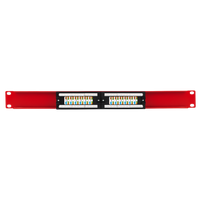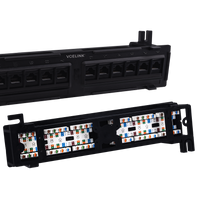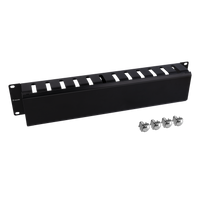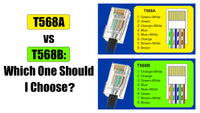Introduction: Why Cabling Components Matter
The strength of your network depends on its components. Any weak element (a frayed cable, a badly punched jack, or a loose connector) will negatively affect the reliability of your network.
Cabling components, or more formally said, connectivity hardware, are network connectivity components. This includes anything that:
- Terminates a cable
- Allows plugging and unplugging cables
- Creates physical points of connection within a network.
Are you setting up a domestic network, growing a business, or setting up a data center? If so, don’t think that performance will depend on having the shiniest switch or the most expensive router. What matters the most is your structured cabling, the organized spine that keeps everything working correctly and flawlessly. With a proper cabling structure, your network will work without issue. Likewise, if cabling is poorly done, you’ll spend hours trying to figure out why you keep experiencing outages.
What Do We Mean by Structured Cabling?
Structured cabling is a standardized system to help you organize and install the cables and hardware that connect your different devices to your network (including computers, servers, cameras, or any other smart gadgets).
Structured cabling uses consistent components, such as patch panels, jacks, connectors, and cable grades, to mention just a few. This system follows industry standards like TIA-568. These standards make it easy to maintain, fix, scale, or certify your network.
In 2021, Telco Data claimed that studies indicated that up to 70% of network issues derive from poor cabling practices or poor components. It emphasizes that bad cabling results in lower performance, increased maintenance costs, and less reliability.
Today, we’ll take a look at every crucial element of structured cabling. We’ll see when and why to use each, and give you some tips to help you avoid costly mistakes.
Expert Tip: Although proper cabling is essential, select the components first. Your choices regarding patch panels, jacks, or fiber connectors will determine your network’s performance ceiling.
Patch Panels: The Nerve Center of Your Network
A patch panel is a mounted piece of hardware that has multiple ports (typically RJ45) on its front and punch-down terminals on its back. The patch panel is where all your permanent cables from devices or wall jacks terminate. Basically, instead of plugging long cables into your switch, you’ll plug flexible, short “patch cords” from the panel to the switch. Having the right patch panel helps you to:
- Keep your rack tidy
- Protect the costly switch ports, thus reducing wear
- Allow you to reconfigure connections within seconds, like making changes or adding new ones.
- Have a centralized place to troubleshoot, right from the panel, not behind the rack.
Without patch panels, you’d be plugging dozens of cables directly into switches. This would create a mess of cables, which would eventually make it a nightmare to perform any troubleshooting or create new connections.
Types of Patch Panels and Buying the Right One
Before purchasing a patch panel, you’ll have to consider several questions, such as:
- How many connections does it need to withstand?
- Must it be fiber optic, twisted pair, coaxial, or support all three?
- Should it be rack-mounted or wall-mounted?
- What speed should it support?
- What category of Ethernet cables will you attach to it?
Why is that so important? Because there are many types of patch panels, classified by different features, these are:
- By category: Cat5e, Cat6, Cat6a, etc. When selecting your patch panel, match or exceed your cable’s rating.
- By shielding: You’ll find shielded patch panels (FTP/SFTP) or unshielded patch panels (UTP). Shielded ones are recommended near motors, or heavy PoE (Power over Ethernet) deployments, while unshielded ones are suitable for quiet homes, offices, or environments with low EMI (electromagnetic interference).
- By loading: There are ready-to-use (also known as pre-loaded) and unloaded (in this case, you’ll have to insert the keystone jacks yourself).
- By mount: Rack-mount or wall-mount. The latter are the best choice for small spaces.
- By shape: You have angled and flat panels. Go for angled panels to improve cable flow in dense racks.
Expert Tip: Always match your panel category to your cables.
Connectors, Jacks, and Outlets: The Interface Layer
Connectors, jacks, and outlets are part of the bigger family of cabling components, also known as connectivity hardware.
For those new to cabling, some terms may be confusing. So, the simple differentiation below might be useful to many of you.
Connectors are the plugs at the end of a cable; the little plastic or metal pieces you introduce into a device, like RJ45 plugs on Ethernet cords.
Jacks (or keystone jacks) are the female parts (little holes) that receive the connectors, like the ports in the patch panel or wall plate.
Outlets are jacks built into a panel or wall, typically with a neat cover. They work like power outlets, but instead of electricity, they are for network cables.
It doesn’t matter how fast your network cables are, or how well-built your cabling is, if the RJ45 plug at the end is badly crimped or if you didn’t punch the keystone jack properly down, your connection won’t work.
These small parts, these little components of structured cabling, are vital for the functioning of a network.
Copper Cabling vs. Fiber Optics
Copper and fiber optic cables are the most commonly used when it comes to data transmission.
Fiber cabling is, undeniably, on the rise. Yet, copper wires, which have been ruling in the field of network cabling for decades, still reign in some settings, like work area runs and PoE devices. Simultaneously, companies that transmit huge amounts of data are turning to fiber optics, as they find copper no longer supports the requirements of the latest technologies.
Both have their advantages and disadvantages. Let’s look at the specs and uses of each.
Copper or Fiber Optics? Comparison Table
Although we’ll get into more details, here’s a quick comparison table between both.
|
Factor |
Copper (Cat6/Cat6a) |
Fiber (OM3/OM4/OS2) |
|
Bandwidth |
1G–10G (up to 100 m Cat6a) |
10G–400G (depending on its type) |
|
Distance |
Up to 100 m |
Hundreds of meters to kilometres |
|
EMI Resistance |
Susceptible (unless shielded) |
Immune |
|
PoE Support |
Strong (90W PoE 802.3bt) |
Not used for PoE |
|
Cost |
Lower materials & tech service |
Higher upfront cost |
|
Upgrade Path |
Limited to 10G |
Scales to 100G+ |
|
Install Complexity |
Easier to terminate onsite |
Requires polishing/cleaning |
1. Copper Cabling
Not as glamorous as its competitor, copper cabling brings many advantages, depending on how and where you’ll use it.
Before turning to fiber optics, consider the characteristics of copper wiring, which is sufficient for domestic or small office usage, and more than capable of sustaining most applications.
Copper cabling uses twisted pairs of copper wires to transmit data. It’s affordable, easy to install, and it’s available in the standardized categories (Cat5e, Cat6, Cat6a, etc.) that determine Internet speed and distance limits.
The secret to success depends on choosing the right grade and realizing when it’s time to upgrade.
|
Cable Type |
Performance |
Best Use Cases |
Notes |
|
Cat5e |
Max 1 Gbps up to 100 m |
Basic offices, older devices, voice runs |
Avoid for new installs unless under strict budget constraints |
|
Cat6 |
10 Gbps up to 55 m; 1 Gbps up to 100 m |
Modern SMBs, Wi-Fi 6 access points, security cameras, etc. |
UTP is fine in low-EMI settings |
|
Cat6a |
10 Gbps up to 100 m (full channel) |
PoE++, data centers, future-proof networks |
Often shielded (FTP) to handle heat & EMI |
|
Cat7 |
10 Gbps up to 100 m |
High-interference environments, crucial cabling in enterprises |
Fully shielded (S/FTP); less common in the U.S., not officially recognized by TIA |
|
Cat8 |
25–40 Gbps up to 30 m |
Data centers, short-distance server-to-server or switch-to-switch links |
Always shielded; limited distance makes it unsuitable for typical office runs |
Expert Tip: For PoE++ deployments (an IEEE 802.3bt advanced Power over Ethernet standard), prefer shielded Cat6a since heat in UTP bundles can degrade performance and shorten cable durability.
2. Fiber Optics
When copper reaches its limits in terms of distance, bandwidth, or EMI, fiber optics dominates.
Fiber optic cabling transmits data through strands of plastic or glass. They transmit it as pulses of light, not electricity, as in the case of copper cabling.
What it does is:
- Make it resistant to electromagnetic interference
- Allow data transmission to achieve higher speeds (over 100Gbps)
- Run long distances (kilometers) without signal loss
Fiber optic cabling is used in data centers, 5G towers, telecom, or any setting where speed and distance do matter, and where interference or latency are unacceptable.
The cons are that its price is higher than copper, and it’s weaker. If you bend it excessively, scratch the connector, or mismatch the transceiver, your connection will fail.
Fiber optic cables come in single-mode and multimode.
But what are the differences between single-mode and multimode fiber optic cables?
- Single-mode fiber has a tiny core that carries one beam of light, which makes it ideal for long-distance connections (up to 80 km or more) with high clarity.
- Multimode fiber has a larger core that carries several light beams traveling simultaneously, which is great for shorter runs (up to 550 m), like inside buildings.
Something of utmost importance before running a single strand of fiber is selecting the right connectors. Each type fits different needs, from massive data centers to tight racks. The most common are:
LC (Lucent Connectors): These are preferred for modern devices and dense patch panels. They are small and precise, a perfect fit for small spaces and high-density setups.
SC (Subscriber Connectors): Simply push them, and they will click in. These sturdy connectors are the solution for older installs or if you prioritize reliability over density.
ST (Straight Tip): These use a solid and bulky twist-lock “bayonet” style. You’ll find them mainly in older industrial networks or campuses. Avoid them for new setups.
MTP/MPO (Multi-fiber Push-On): Such connectors carry 12, 24, or more fibers in a single plug, which makes them essential for 40G, 100G, and 400G Ethernet data center links. A bit pricier than other connectors, these are the only option for hyperscale environments or spine-leaf architectures.
Supporting Hardware for a Structured Network
Supporting hardware refers to all the parts or components that keep your structured cabling system organized and protected. None of these components carries data or appears on the diagram or sketch of your network. Nonetheless, they are vital components of proper cable management, and without them, everything might fall apart. That’s how important they are.
We are talking, for example, about:
Cable managers: Vertical ones are mounted on racks’ sides, and horizontals go above or below the equipment.
Velcro straps: These reusable, adaptable, and gentle straps keep cables in order without damaging them.
Blanking (or filler) panels: They are used to fill empty spaces within racks and prevent hot air from accumulating.
Grounding bars: These are mandatory for shielded patch panel systems and bond all shields to one ground point.
Racks and enclosures (or cabinets): These are a must to keep your equipment organized.
Pathways (ladder racks, trays, J-hooks): Use them to keep your cables supported.
Why Choosing the Right Components Matters
Choosing the right structured cabling components is important because making the wrong decision can translate into later downtime, rework (maybe even a total re-cabling), and unexpected costs in more spare parts and technical service.
Try to change your mindset, and instead of thinking of cables, jacks, or panels as physical elements of your network, think of them as tactical decisions. Taking uninformed decisions or basing them only on the prices of each component can mean getting trapped in low speeds, frequent failures, or costly replacements.
Choose wisely and you’ll build a platform that will work efficiently and will be able to scale without further time and money investments. When setting up a network, consider getting the right components. Each component plays its part in whether your network can last over 10 years or disappoint you soon afterwards.
So, selecting every component of your network is applying a strategy in a physical form.
Conclusion: Components Are the Foundation of Your Network
Structured cabling is the foundation of your whole IT infrastructure.
Getting the right components will enable you to scale your network without effort, fix issues quickly, and work steadily for years.
Yet, if you select every component without considering its features, specifications, and interrelations, you’ll be signing a contract for unexplained outages, unplanned upgrades, and avoidable downtime (which directly affects business productivity).
The success of current and future networking requires not just proper cabling; it requires a structured cabling strategy. Invest in structured cabling, and you’ll be building a platform ready to face current and future networking challenges.
Frequently Asked Questions
Q: What’s structured cabling?
A: It’s a standardized system made of cables, connectors, and any hardware designed to support multiple hardware usages while being vendor-neutral.
Q: How long does copper cabling last?
A: Typically, it could last 10 to 15 years, but its performance also depends on the quality of the installation and the environment.
Q: What’s harder to install, fiber or copper?
A: Fiber optic cables require more precision, cleaning, and testing. Yet, their pre-terminated fiber assemblies ease deployment.
Q: Do I need Cat6s or Cat7?
A: Depends on your install. For most commercial installations, Cat6a suffices. Cat7 and Cat8 are usually data-center specific.
Q: Can I mix copper and fiber in the same network?
A: Categorically, yes. Many networks use fiber backbones and copper to access points or desks.
If you have other questions, don’t hesitate to ask us. We’ll be pleased to respond to your queries or even write an in-depth, explanatory article about it.






Geben Sie als Erster einen Kommentar ab.
Hinterlasse einen Kommentar